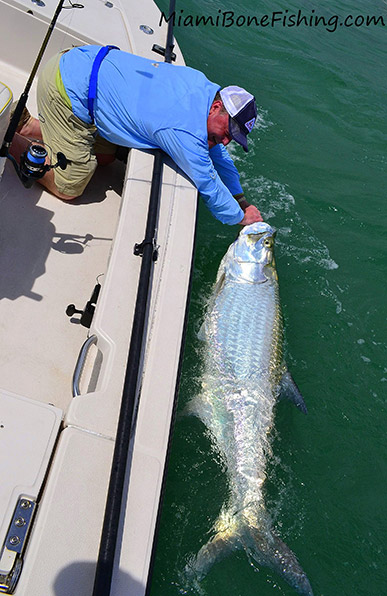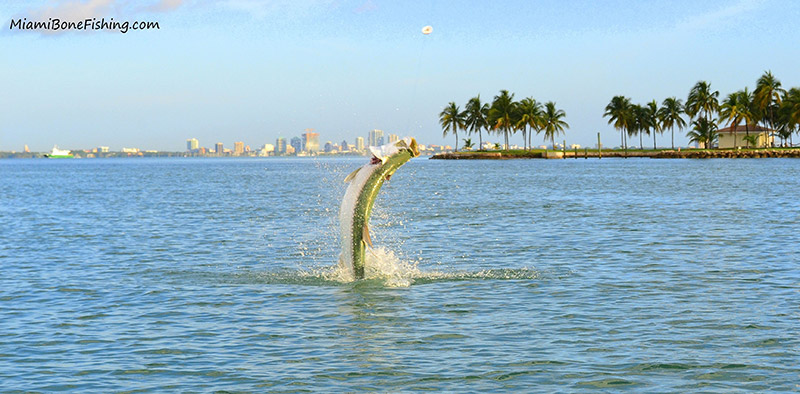Email:CaptMo@netzero.com | Tel:(786)853-1409 | BOOK A CHARTER
HOME CONTACT ABOUT CAPT. MO GALLERY VIDEOSBOOK A CHARTER MO'S FISHING REPORT TESTIMONIALS ABOUT BISCAYNE BAYABOUT CHARTERSLINKS
Permit
The Tarpon
Tarpon are one of the strongest fighters in Miami’s Biscayne Bay and Capt. Mo has been successfully running tarpon fishing charters in Miami fishing for them for over fifteen years. Whether on the flats in the spring and early summer or in deeper water during the fall and winter, Capt. Mo will put you on the tarpon of your dreams. Our Miami tarpon fishing take place inshore where I run Miami inshore fishing charters and the tarpon is an incredible fighter that will leave you sore and exhausted. For the ultimate inshore fishing charter in Miami, a Miami fly fishing tarpon charter is the way to go.
One of Florida’s most spectacular game fish, the tarpon is a smart and hard fighter whose powerful leaps from the water and bone-jarring bursts of speed test the skill and fortitude of even the most experienced angler.
A hardy giant that can survive in a variety of habitats and salinities, the tarpon can even gulp air for extended periods when not enough oxygen is present in the water to sustain it. Despite its popularity among sport fishermen, many aspects of this extremely long-lived fish’s life cycle and behavior remain a mystery.
Tarpon are silvery colored with blue-gray backs. Underwater, they appear to shimmer like huge gray ghosts as they swim sedately by. This appearance, along with their impressive size, is likely responsible for their nickname, “silver king.” The huge mouth of the tarpon has a projecting, upturned lower jaw that contains an elongated bony plate making it difficult for anglers to set a hook.
Until recently, tarpon were thought to have a life span of only about 15 years. However, using more accurate techniques to count annually deposited rings in the earbones (otoliths) of fish, researchers found one individual that had lived 55 years. However, many of the fish caught in the fishery are 15 to 30 years old. The world’s fishing record for a tarpon was set in 2003 when a tarpon weighing 286 pounds, 9 ounces
was landed in Guinea-Bissau, Africa. The Florida record for tarpon caught with conventional tackle was a 243-pound fish captured off Key West in 1975.During a Miami Tarpon fishing charter, its’s important to book the right Miami Tarpon fishing guide with the right experience and equipment. Capt. Mo targets tarpon using spinning and fly tackle with anglers of all skill levels.
Range and Habitat
Although tarpon have been reported as far north as Nova Scotia and have also been found off the coast of Ireland, they prefer tropical and subtropical waters and are most common from Virginia to central Brazil and throughout the Caribbean Sea and Gulf of Mexico. Because tarpon are sensitive to cold water, their range is generally limited to temperate climates.
In Florida, they are found in water depths ranging from less than 3 feet to more than 80 feet.
Tarpon thrive in a variety of habitats. Adults are believed to move offshore to marine waters to spawn, and the larvae gradually make their way back inshore to marshes and mangrove embayments in estuaries. Adults frequent a range of habitats, from offshore and
nearshore coastal waters to stagnant pools off of riverine habitats. They can often be seen patrolling the coral reefs of the Florida Keys.Life History
In May and June, tarpon begin gathering together in areas near the coast in preparation for the journey to their offshore spawning grounds. In these coastal staging areas, scientists and fishermen have observed schools of tarpon swimming in a circular, rotating
motion. This behavior, known as a “daisy chain,” may be a sort of prenuptial tarpon tango that
prepares the fish for spawning. The actual exodus to the offshore spawning areas is probably triggered by lunar phases and tides. During one spawning season, it is estimated that
a mature female may produce from 4.5 to 20.7 million eggs. The larger and heavier the fish, the more eggs she is likely to shed. Spawning in Florida occurs mainly in May, June, and
July. The juvenile tarpon make their way into marshes and mangrove swamps, where they will spend the remainder of the first year of their lives. They are
often found in stagnant pools. They grow rapidly and are about a foot long within one to two years. Females usually grow more quickly and are larger than males, and both reach sexual maturity at around 10 years of age. Tarpon are often found in schools with other
tarpon and are opportunistic eaters that feed on a variety of fish and crabs. Although tarpon appear to be sensitive to noise and boat traffic and may become skittish and reluctant
to take bait when the waters are crowded with boaters, tarpon are unlike many other fish in that
they can frequently be found in highly urbanized areas with poor water quality. They will take a variety of live and dead bait, as well as artificial lures and flies.Courtesy of Florida Wildlife Commission
Scroll through the pics to the right to see some of Captain Mo's latest adventures:
It could be you posing with one of those beauties!
Book a charter today. All ages and skill levels welcome.
(786)853-1409.
Home | Contact | About Capt. Mo | Gallery
Mo's Fishing Report | Testimonials | About Biscayne Bay | About Charters | Links





